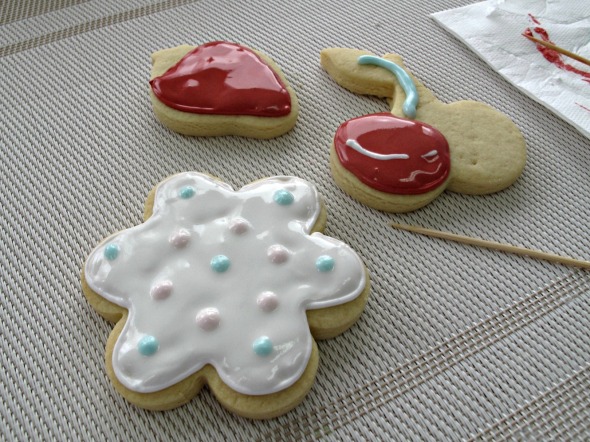Julia’s work – how they’re meant to look.
My beginner class efforts.
Consider The Sauce loves rabbit holes and those who gleefully scamper down them – people who are devoted with joy and passion to their “thing”.
Julia – Miss Biscuit – certainly qualifies.
Since CTS first write about her biscuit decorating pursuits more than three years ago, her dedication has paid dividends.
She’s found the desire for knowledge about her “thing” is so wide and deep that she’s been able to make it her main gig, moving her operations from her Yarraville home to a two-storey headquarters in Seddon.
As well, she has become an employer, has embarked on a teaching tour of the Middle East, is bringing specialists from overseas to teach here and has taught many thousands of students and fans herself.
Decorating cookies is never going to something I’ll pursue, but I’m nevertheless extremely grateful for the opportunity to sit in on one of Julia’s beginner classes.
She’s a fine teacher – in this regard, she draws on her background as a speech pathologist. Our class is a mix of information and hands-on practice in the form of decorating nine cookies ourselves.
The information comes in the form of making the base cookies; we are provided three different recipes – Miss Biscuit Vanilla Sugar Biscuits, Gingerbread (Adapted from Bake at 350) and Decadent Chocolate Roll Out Cookies.
The important thing here is that the recipes result in cookies that don’t lose their shape once they’re cut and baked.
Then there is the royal icing itself.
We are led through the basic recipe, then the various consistencies and colours and their uses, as well as the use of piping bags and squeeze bottles.
Finally, there is the matter of piping-bag tips, with some brands being much more favoured than others, and some (the narrow ones) being used for outlining and the wider ones being utilised for flooding, the all-over icing technique that covers whole – or whole parts – of cookies, creating a sort of blank canvas for more ornate artwork and detail.
After demonstrations by Julia of the techniques involved, it’s time to give it a crack ourselves, firstly by trying outling on patterns on paper.
They key to outlining, we’ve been told, is to have tip about inch from the cookie.
I’m surprised at how easy to work the royal icing is.
Mind you, as a rank beginner I do struggle – I try to concentrate on a certain fluidity, a steady hand, some momentum.
Flooding is something quite different – apparently a little easier to do, but I soon find out I have been too sparing in my icing applications.
As we finish the early stages of each cookie, they are set aside so the icing can dry and we move on to the next.
During the lunch break, various of my classmates avail themselves of the cookie cutters and much more available in the shop downstairs.
After lunch, we get back to work by adding details to our cookies.
It’s at this point my outlining technique gets well and truly found out – the lattice-work on my ice-cream cone and cupcake is squiggly where it should be straight!
Still, in the end I am delighted and surprised that all my cookie artwork actually looks recognisably as it is meant to.
The concentration levels have been nothing unusual for me, but the subject of that concentration has been very different – so I am pretty tired by the end of the five-hour class.
But I’ve had a ball.
Check out the Miss Biscuit website here for details of classes, products and more.











